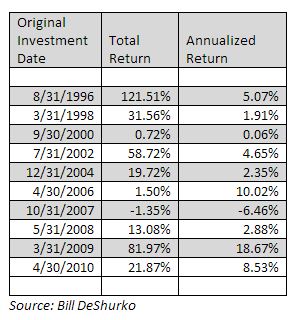 Author: Bill DeShurko, 401 Advisor
Author: Bill DeShurko, 401 Advisor
Covestor model: Dividend and Income Plus
I recently saw a headline from yet another new study “confirming” that market timing doesn’t work. My purpose here is to lay out why such a conclusion is absolutely wrong, and can be extremely detrimental to individual investors.
First, let’s understand the term “market timing.” It’s a pretty straightforward concept. Market timing simply involves getting in and out of the market in such a way to allow an investor to avoid some market losses while participating in most market gains.
This simplification misses the key element to a practical market-timing system: time frame. For example, to an MIT wonk, market timing may concern how many trades can be executed in a nanosecond. By comparison, let’s look at a hypothetical market-timing strategy that uses the 200-day moving average (DMA) — selling when the SPY falls under the 200 DMA and buying again when it moves over it. We’ll add a five-day delay to both the sell and buy signal to avoid whipsaws — very short-term trades where the security price crosses the trading signal of the 200 DMA, but bounces back within a couple days.
Hypothetically, applying this trading signal to SPY, the SPDR’s S&P 500 Index tracking ETF, comes up with a total of 14 trades to an account since Jan. 1, 2000. That’s barely over one trade a year, and a far cry from the computer frenzy of high-frequency trading (HFT).
Now, we know that HFT can be extremely profitable, as evidenced by the enormous sums of money and human capital expended in the pursuit. Our hypothetical timing system is nowhere near as profitable, but as part of an overall strategy — such as my Dividend and Income Plus model — it can add value.
From Jan. 1, 2000, through market close Sept. 28, 2012, SPY has had a buy-and-hold average annual return of 2.06%. Applying the 200 DMA rule with a five-day-delay strategy more than doubles the average annual return to 4.68%. But more valuable to real investors, the system would have avoided most of the carnage of 2000-2002 and 2007-2009. During the first selloff, SPY dropped 44.15%. Our system would have called for an exit after just a 12.06% drop. In the latter example, SPY dropped 54.37%, and our hypothetical system would have exited SPY with a maximum loss of 15.86%.
Clearly, market timing can work. That doesn’t mean it “does” or “doesn’t” work as a blanket statement. All any study that claims to prove or disprove that market timing works can say is that if you market time using a very specific security, or definable group of securities, using specific timing criteria, that very specific system, using those exact repeatable criteria, either does or does not work. In English: don’t assume that a 200-day simple moving average with a five-day delay, or any other particular system, will work or not work for any other security, over any other time frame, than for SPY from Jan. 1, 2000 through the end of September 2012. Period.
So with all the possible timing systems out there that could be designed to trade between a nanosecond and once or twice a year, and choosing among the thousands of securities that could be traded, it is absolutely no surprise that thousands upon thousands of articles could be written about market-timing systems that don’t work. But understand that that by no means provides any evidence that there exists no timing systems that does work.
The typical corollary to “market timing doesn’t work” is that “timing of an investment doesn’t matter – it’s time in the market that matters.”
Below in Figure 1 is a graph of SPY, monthly returns since 1996 (dividends reinvested, total return). The lines indicate hypothetical investment points for a hypothetical investor through the end of September.
From the slope of each line you can see the obvious relative differences in return based on when an investment is made. Below, in Figure 2, is a chart showing the buy-and-hold total returns and annualized returns for our hypothetical investors based on a fairly random selection of investment dates.
Based on these examples, an investor in SPY from 2000 through 2010 could have had anywhere from a negative 6.46% to a positive 18.67% annualized return. If investing is really just about “time in the market”, then please explain why an investor on Sept. 30, 2000, had a total return of .72% while an investor with just three-and-a-half years in the market has a total return of 81.97%?
The points to be made seem pretty obvious, but hey, I’ve only been doing this stuff for 25 years:
- There are far more unsuccessful ways to try to time the market than successful ones. That doesn’t mean that no market-timing techniques work. Simple techniques can add significant value to your portfolio. Most professional investors that I know employ timing techniques to reduce volatility – less so to increase returns.
- Timing matters. When you invest is most likely the single biggest investment decision that you will make. Run away when someone tells you that “anytime is a great time to invest!”
- No system works 100% of the time. It doesn’t have to. Give any strategy a full market cycle to measure its true worth.
Disclosures: The index comparisons herein are provided for informational purposes only and should not be used as the basis for making an investment decision. There are significant differences between client accounts and the indices referenced including, but not limited to, risk profile, liquidity, volatility and asset composition. The S&P 500 is an index of 500 stocks chosen for market size, liquidity and industry, among other factors.
Any investments discussed in this presentation are for illustrative purposes only and there is no assurance that the adviser will make any investments with the same or similar characteristics as any investments presented. The investments are presented for discussion purposes only and are not a reliable indicator of the performance or investment profile of any composite or client account. Further, the reader should not assume that any investments identified were or will be profitable or that any investment recommendations or that investment decisions we make in the future will be profitable.





